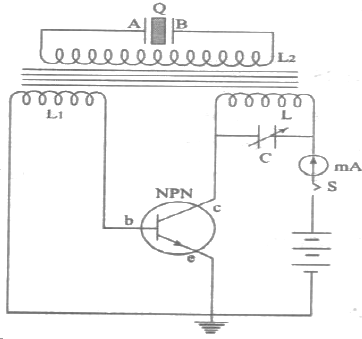SKEDSOFT
Piezoelectric generator: A slab of piezoelectric crystal is taken and using this a parallel plate capacitor is made. Then with other electronic components an electronic oscillator is designed to produce electrical oscillations > 20 kHz. Generally one can generate ultrasonic waves of the order of MHz using piezoelectric generators. Quartz slabs are preferred because it possesses rare physical and chemical properties. A typical circuit diagram is given below.

The tank circuit has a variable capacitor 'C' and an inductor 'L' which decides the frequency of the electrical oscillations. When the circuit is closed current rushes through the tank circuit and the capacitor is charged, after fully charged no current passes through the same. Then the capacitor starts discharging through the inductor and hence the electric energy is in the form of electric and magnetic fields associated with the capacitor and the inductor respectively. Thus we get electrical oscillations in the tank circuit and with the help of the other electronic components including a transistor, electrical oscillations are produced continuously. This is fed to the secondary circuit and the piezoelectric crystal (in our case a slab of suitably cut quartz crystal) vibrates, as it is
continuously subjected to varying (alternating) electric field, and produces sound waves. When the frequency of electrical oscillations is in the ultrasonic range then ultrasonic waves are generated. When the frequency of oscillation is matched with the natural frequency of the piezoelectric slab then it will vibrate with maximum amplitude. The frequency generated is given as follows:
